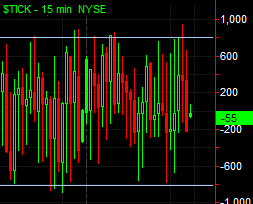As you know by now, I am mostly a stock trader. And nothing strikes fear into the heart of the long-side stock holder than the dreaded earnings report. This is the single most important news event for any individual stock. And it comes just 4 times per year just as surely as the rotation of the Sun, Moon and the Earth which governs most of our other natural cycles.
What makes the earnings report so important is that it is so rare. There are about 250 trading days per year in the stock market and only 4 of them are earnings days for any single stock. That means an earnings day is a 4/250 event or put another way only occurs about 1.6% of the time. And that spells opportunity for the astute trader in a few ways as follows:
1) The Earnings Miss - This happens when a stock with good fundamentals and a good chart etc releases earnings which don't live up to expectations. This is especially common when the stock had a big run-up into earnings, see below for that. In any case, the stock is unduly punished and sells off hard in a manner disproportionate to the rest of the market. In the above case, IBM sold about 5% on the earnings news which was way beyond the fraction of 1% move in the general market.
Anyway, the Earning Miss provides a buying opportunity for the astute trader, as long the earnings news does not contain any substantial fundamental developments affecting the company. This means you should read the earnings report and/or listen to the earnings conference call before forming your opinion. You don't need to have an MBA or understand what is meant by SG&A. Just listen to the call, read the news and form your opinion, its not that hard. In my case, I decided to buy IBM at the blue bar above and I am sticking with it for a gap fill up to about 207. That may seem like a big move, but remember, IBM is a Dow-30 stock with really good management the indexers have to buy it. They have no choice.
2) The Run-Up into Earnings - This happens when a great stock with great fundamentals runs up into earnings. Case in point is Amerisource Bergen (ABC). This stock has solid fundamentals, 5-year earnings growth of almost 20%, PE of about 19% and a yield of 1.6%. Its always encouraging to see a stock with a 5-year earnings growth rate greater than the PE. Cramer says you can pay a multiple of up to 2X the PE, so stocks in this situation are undervalued and can rise substantially from here.
All that being said the earnings date can make or break the play. In the case of ABC, I bought into the run-up ahead of earnings and sold right into the rally at about $56.70 the day before earnings came out. The earnings were not bad, just not stellar and that was enough to knock the stock down and I re-loaded at the blue bar above. Sure the stock can drop from here - and it did in my case. But you have to have conviction in the story based on your own research. If you don't have conviction, don't take the trade.
 3) The Sell-Off into Earnings - This happens when a stock with pretty good fundamentals sells of before earnings in anticipation of bad news. Once the new comes out, sometimes the news was not quite as bad as expected and the stock rallies.. Case in point in my favorite Health Care cost containment play HMS Systems symbol HMSY.
3) The Sell-Off into Earnings - This happens when a stock with pretty good fundamentals sells of before earnings in anticipation of bad news. Once the new comes out, sometimes the news was not quite as bad as expected and the stock rallies.. Case in point in my favorite Health Care cost containment play HMS Systems symbol HMSY.Check out the daily chart of HMSY. The stock recently sold off hard on the daily chart from a high of 31 and change all the way down to about the mid 22's. I almost sold the stock ahead of earnings because it looked so bad. But listening the earnings call,
I understood that the earnings miss - which was predicted and realized - was based on short term uncertainties related to adoption of government-reimbursed health care contracts which is the core of the long-term story behind this company. Net result was a buying opportunity and I bought on the blue bar shown above.
Granted I could be totally wrong on all of the above plays. The stock market could go into the toilet based on terrorism macro or other unexpected factors leading to a big loss of my principal. But we are in a major bull market and learning and understanding the fundamental factors behind you investments give you conviction to stick with the story or even buy when the charts look bad.
Okay, I'll get off my soap-box now. Enjoy your weekend.









